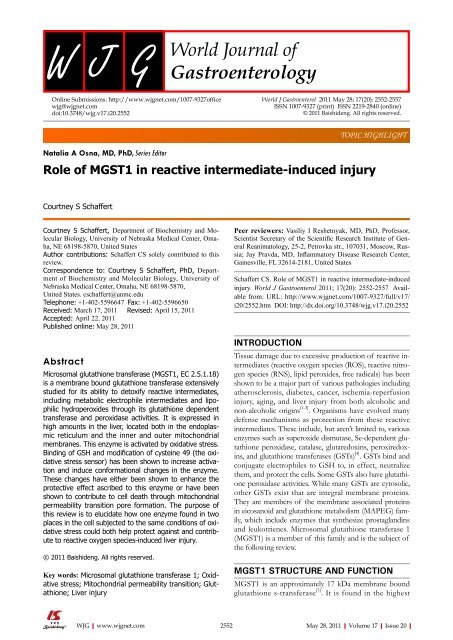20 - World Journal of Gastroenterology
20 - World Journal of Gastroenterology
20 - World Journal of Gastroenterology
Create successful ePaper yourself
Turn your PDF publications into a flip-book with our unique Google optimized e-Paper software.
Online Submissions: http://www.wjgnet.com/1007-9327<strong>of</strong>fice<br />
wjg@wjgnet.com<br />
doi:10.3748/wjg.v17.i<strong>20</strong>.2552<br />
Natalia A Osna, MD, PhD, Series Editor<br />
Role <strong>of</strong> MGST1 in reactive intermediate-induced injury<br />
Courtney S Schaffert<br />
Courtney S Schaffert, Department <strong>of</strong> Biochemistry and Molecular<br />
Biology, University <strong>of</strong> Nebraska Medical Center, Omaha,<br />
NE 68198-5870, United States<br />
Author contributions: Schaffert CS solely contributed to this<br />
review.<br />
Correspondence to: Courtney S Schaffert, PhD, Department<br />
<strong>of</strong> Biochemistry and Molecular Biology, University <strong>of</strong><br />
Nebraska Medical Center, Omaha, NE 68198-5870,<br />
United States. cschaffert@unmc.edu<br />
Telephone: +1-402-5596647 Fax: +1-402-5596650<br />
Received: March 17, <strong>20</strong>11 Revised: April 15, <strong>20</strong>11<br />
Accepted: April 22, <strong>20</strong>11<br />
Published online: May 28, <strong>20</strong>11<br />
Abstract<br />
Microsomal glutathione transferase (MGST1, EC 2.5.1.18)<br />
is a membrane bound glutathione transferase extensively<br />
studied for its ability to detoxify reactive intermediates,<br />
including metabolic electrophile intermediates and lipophilic<br />
hydroperoxides through its glutathione dependent<br />
transferase and peroxidase activities. It is expressed in<br />
high amounts in the liver, located both in the endoplasmic<br />
reticulum and the inner and outer mitochondrial<br />
membranes. This enzyme is activated by oxidative stress.<br />
Binding <strong>of</strong> GSH and modification <strong>of</strong> cysteine 49 (the oxidative<br />
stress sensor) has been shown to increase activation<br />
and induce conformational changes in the enzyme.<br />
These changes have either been shown to enhance the<br />
protective effect ascribed to this enzyme or have been<br />
shown to contribute to cell death through mitochondrial<br />
permeability transition pore formation. The purpose <strong>of</strong><br />
this review is to elucidate how one enzyme found in two<br />
places in the cell subjected to the same conditions <strong>of</strong> oxidative<br />
stress could both help protect against and contribute<br />
to reactive oxygen species-induced liver injury.<br />
© <strong>20</strong>11 Baishideng. All rights reserved.<br />
Key words: Microsomal glutathione transferase 1; Oxidative<br />
stress; Mitochondrial permeability transition; Glutathione;<br />
Liver injury<br />
WJG|www.wjgnet.com<br />
2552<br />
<strong>World</strong> J Gastroenterol <strong>20</strong>11 May 28; 17(<strong>20</strong>): 2552-2557<br />
ISSN 1007-9327 (print) ISSN 2219-2840 (online)<br />
© <strong>20</strong>11 Baishideng. All rights reserved.<br />
Peer reviewers: Vasiliy I Reshetnyak, MD, PhD, Pr<strong>of</strong>essor,<br />
Scientist Secretary <strong>of</strong> the Scientific Research Institute <strong>of</strong> General<br />
Reanimatology, 25-2, Petrovka str., 107031, Moscow, Russia;<br />
Jay Pravda, MD, Inflammatory Disease Research Center,<br />
Gainesville, FL 32614-2181, United States<br />
Schaffert CS. Role <strong>of</strong> MGST1 in reactive intermediate-induced<br />
injury. <strong>World</strong> J Gastroenterol <strong>20</strong>11; 17(<strong>20</strong>): 2552-2557 Available<br />
from: URL: http://www.wjgnet.com/1007-9327/full/v17/<br />
i<strong>20</strong>/2552.htm DOI: http://dx.doi.org/10.3748/wjg.v17.i<strong>20</strong>.2552<br />
INTRODUCTION<br />
TOPIC HIGHLIGHT<br />
Tissue damage due to excessive production <strong>of</strong> reactive intermediates<br />
(reactive oxygen species (ROS), reactive nitrogen<br />
species (RNS), lipid peroxides, free radicals) has been<br />
shown to be a major part <strong>of</strong> various pathologies including<br />
atherosclerosis, diabetes, cancer, ischemia-reperfusion<br />
injury, aging, and liver injury from both alcoholic and<br />
non-alcoholic origins [1-3] . Organisms have evolved many<br />
defense mechanisms as protection from these reactive<br />
intermediates. These include, but aren’t limited to, various<br />
enzymes such as superoxide dismutase, Se-dependent glutathione<br />
peroxidase, catalase, glutaredoxins, peroxiredoxins,<br />
and glutathione transferases (GSTs) [4] . GSTs bind and<br />
conjugate electrophiles to GSH to, in effect, neutralize<br />
them, and protect the cells. Some GSTs also have glutathione<br />
peroxidase activities. While many GSTs are cytosolic,<br />
other GSTs exist that are integral membrane proteins.<br />
They are members <strong>of</strong> the membrane associated proteins<br />
in eicosanoid and glutathione metabolism (MAPEG) family,<br />
which include enzymes that synthesize prostaglandins<br />
and leukotrienes. Microsomal glutathione transferase 1<br />
(MGST1) is a member <strong>of</strong> this family and is the subject <strong>of</strong><br />
the following review.<br />
MGST1 STRUCTURE AND FUNCTION<br />
MGST1 is an approximately 17 kDa membrane bound<br />
glutathione s-transferase [5] . It is found in the highest<br />
May 28, <strong>20</strong>11|Volume 17|Issue <strong>20</strong>|

















